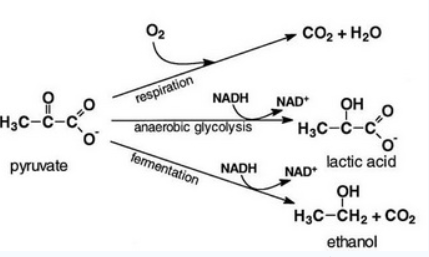
The stage up to which glycolysis and fermentation have a common pathway is
A. Dihydroxyacetone
B. 3-phosphoglyceraldehyde
C. Pyruvate
D. Glucose-6-phosphate
Answer
574.2k+ views
Hint: Glycolysis takes place in the cytoplasm anaerobically up to pyruvate production then decides it will undergo oxidative metabolism or anaerobic metabolism.

Complete answer: 1. Glucose-6-phosphate production from glucose is the first step of glycolysis.
It involves the enzyme hexokinase and Mg$^{2+}$ (magnesium ion).
2. 3-phosphoglyceraldehyde (3-PG) and dihydroxyacetone phosphate (DHAP) is produced in the 4th step of glycolysis from fructose-1,6-bisphosphate.
This reaction is catalyzed by aldolase enzyme and it cleaves 6 carbon compound fructose-1,6-bisphosphate to produce 3-PG and DHAP.
3. In the final step of glycolysis, pyruvate is produced by the enzyme pyruvate kinase from phosphoenolpyruvate or PEP.
ATP is also produced in this reaction.
4. Fermentation is a chemical breakdown of pyruvate to form alcohol which is an anaerobic process. It also generates heat as energy.
So, upto pyruvate production, the pathway for glycolysis and fermentation is similar.
Hence, for this question, the correct answer is option C. Pyruvate.
Note: The enzyme kinase uses ATP and Mg$^{2+}$ ion for its activity and this enzyme adds a phosphate group in its product but the pyruvate kinase enzyme helps in the production of ATP.
One more exception is in the glycolysis pathway that is the enzyme phosphoglycerate kinase also helps in the production of ATP by removing a phosphate group from its substrate 1,3-bisphosphoglycerate and producing 3-phosphoglycerate.

Complete answer: 1. Glucose-6-phosphate production from glucose is the first step of glycolysis.
It involves the enzyme hexokinase and Mg$^{2+}$ (magnesium ion).
2. 3-phosphoglyceraldehyde (3-PG) and dihydroxyacetone phosphate (DHAP) is produced in the 4th step of glycolysis from fructose-1,6-bisphosphate.
This reaction is catalyzed by aldolase enzyme and it cleaves 6 carbon compound fructose-1,6-bisphosphate to produce 3-PG and DHAP.
3. In the final step of glycolysis, pyruvate is produced by the enzyme pyruvate kinase from phosphoenolpyruvate or PEP.
ATP is also produced in this reaction.
4. Fermentation is a chemical breakdown of pyruvate to form alcohol which is an anaerobic process. It also generates heat as energy.
So, upto pyruvate production, the pathway for glycolysis and fermentation is similar.
Hence, for this question, the correct answer is option C. Pyruvate.
Note: The enzyme kinase uses ATP and Mg$^{2+}$ ion for its activity and this enzyme adds a phosphate group in its product but the pyruvate kinase enzyme helps in the production of ATP.
One more exception is in the glycolysis pathway that is the enzyme phosphoglycerate kinase also helps in the production of ATP by removing a phosphate group from its substrate 1,3-bisphosphoglycerate and producing 3-phosphoglycerate.
Recently Updated Pages
Master Class 12 English: Engaging Questions & Answers for Success

Master Class 12 Business Studies: Engaging Questions & Answers for Success

Master Class 12 Economics: Engaging Questions & Answers for Success

Master Class 12 Social Science: Engaging Questions & Answers for Success

Master Class 12 Maths: Engaging Questions & Answers for Success

Master Class 12 Chemistry: Engaging Questions & Answers for Success

Trending doubts
What are the major means of transport Explain each class 12 social science CBSE

Which are the Top 10 Largest Countries of the World?

Draw a labelled sketch of the human eye class 12 physics CBSE

Explain sex determination in humans with line diag class 12 biology CBSE

The pH of the pancreatic juice is A 64 B 86 C 120 D class 12 biology CBSE

Explain sex determination in humans with the help of class 12 biology CBSE




